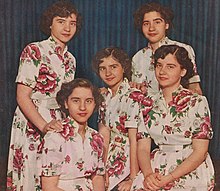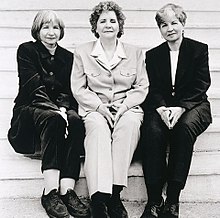Dionne quintuplets

The Dionne quintuplets were the first known surviving quintuplets. The five identical girls Yvonne (Edouila Marie), Annette (Lillianne Marie), Cécile (Marie Emilda), Emilie (Marie Jeanne) and Marie (Reina Alma) were born on May 28, 1934 with the help of the country doctor Allan Roy Dafoe and two midwives in was born in a hut without water or electricity in the town of Corbeil in the north of the Canadian province of Ontario . Their birth weight was barely more than 1000 grams - together they only weighed 6670 grams. Since none of the quintuplets known to date had survived more than 50 minutes, Dafoe gave the newborns no chance of survival and called a clergyman for a final rites . Despite being fed a solution of corn syrup, water, cow's milk, and rum, surprisingly all of them survived.
There are different opinions about the actual place of birth, as the family farm was located between two cities. However, their birth was recorded in Corbeil , which the parents considered their hometown. Since the somewhat larger neighboring town of Callander received more income from marketing the children, it is often claimed that they were born there.
family
The parents were the Franco-Ontarians Elizire Legros (* 1909; † November 1986) and Oliva Dionne (* 1903 in Corbeil, Ontario; † 1979), who had married in 1925. The quintuplets had nine other siblings, three older brothers, three older sisters, and three younger brothers. Ernest was the oldest. He was born in December 1926. Rose was born in 1928 as the oldest daughter. Therese was born in May 1929. In 1930 Elizire gave birth to a child named Leo who died of pneumonia in infancy. Daniel was born in April 1932. He converted his childhood home into the Dionne Quints Museum . Pauline was born in 1933 and was only eleven months older than the quintuplets. Oliva Jr. was born in 1936, two years after the quintuplets. Victor was born in 1938 as the twelfth child. Claude, the youngest of the family, was born in 1946.
Life
Due to financial problems, the parents made the decision to exhibit the children at the world exhibition in Chicago , whereupon the Ontario government under Mitchell Hepburn withdrew their custody of them in 1935 and forbade closer contact. The children were raised in a hospital across from their parents' house by their obstetrician Allan Roy Defoe and three other carers and used by science as a study object. Defoe let her act temporarily as an advertising medium for corn syrup and the Quaker Oats Company and became richly and internationally known by marketing the girls.
After the renovation of the Quintland amusement park , the authorities themselves put them on display twice a day in front of around 6,000 visitors behind one-sided mirror glass in front of a total of around three million onlookers and brought the Canadian treasury about 500 million dollars. The amusement park has become Ontario's largest contemporary tourist attraction. In addition, the quintuplets performed various performances in front of an audience, especially the performance There Will Always be an England was particularly successful.
In order to be able to tell the children apart, they were given different colors and identifying features. Yvonne, the biggest of the children, wore the color pink and was identified by a robin , Annette the color mauve and a maple leaf . Cecile was green and a turkey, and Emilie was yellow and a tulip . Marie, the smallest, could be identified by the color blue and a teddy bear .
Because of their notoriety, the girls had the opportunity to meet Queen Elizabeth Bowes-Lyon and were used to baptize several warships. The Dionne Quintuplets Museum still exists in the neighboring town of North Bay today .
In 1943 the parents got their children back with the help of a lawyer. However, the children had a disturbed relationship with their parents and were abused by the parents and sexually abused by the father. Dafoe died shortly afterwards on June 2, 1943. At the age of 19, they left home and broke off contact.
Emilie had children within a marriage, but died shortly afterwards at the age of 20 on August 6, 1954 of an epileptic fit , just before she wanted to take her vow of chastity and go to a convent as a nun. Marie became a florist and died at home of a brain thrombus on February 27, 1970 . All of the sisters had a total of ten children.
Yvonne, Annette and Cécile later lived in seclusion in a suburb of Montreal . Cécile was temporarily married. Her son Bertrand later researched the quintuplets' income to the state and found that they had received disproportionately little, whereupon the three surviving sisters sued the Ontario government and three years later were awarded $ 4 million in damages. In 1995, the three sisters published an autobiography called We Were Five , criticizing multiple births for entertainment and declaring that "our lives have been ruined."
Yvonne remained unmarried and spent part of her life in a monastery . She died of cancer on June 23, 2001 .
Ontario's then Prime Minister Mike Harris apologized to Yvonne, Cécile and Annette for the exploitation in 1998 and awarded the women four million Canadian dollars in compensation.
“We were the most popular peep show in the world. Our childhood was like a very long winter ... although we did not have to do without food or material amenities. However, our hunger for love was not satisfied.
The best thing a person can have in life is a happy childhood. By intervening, the government betrayed us. Every child, whether twin, triplet or quintuplet, is unique. Make sure that this individuality is never disregarded or restricted! "
Movies
The life of the quintuplets has been the subject of several Hollywood films.
- The Country Doctor (1936)
- Reunion (1936)
- Five of a Kind (1938)
- Quintupland (1938)
- Snatched from Mother ( Million Dollar Babies ) (1994, Canada / USA)
Even Walt Disney picked up the story in 1937 in Pluto's Quin-puplets on.
In the films, they were played by different triplets and twins depending on their age . During the shooting they were present themselves at times and described this as a painful experience ("To see how sad our life actually was, it hurts a lot." (Annette))
See also
Web links
- "The 500 million dollar babies" , background and commented photo gallery, one day , January 25, 2018
- A life as a circus attraction from Die Welt on June 30, 2001
- quintland.com (English)



